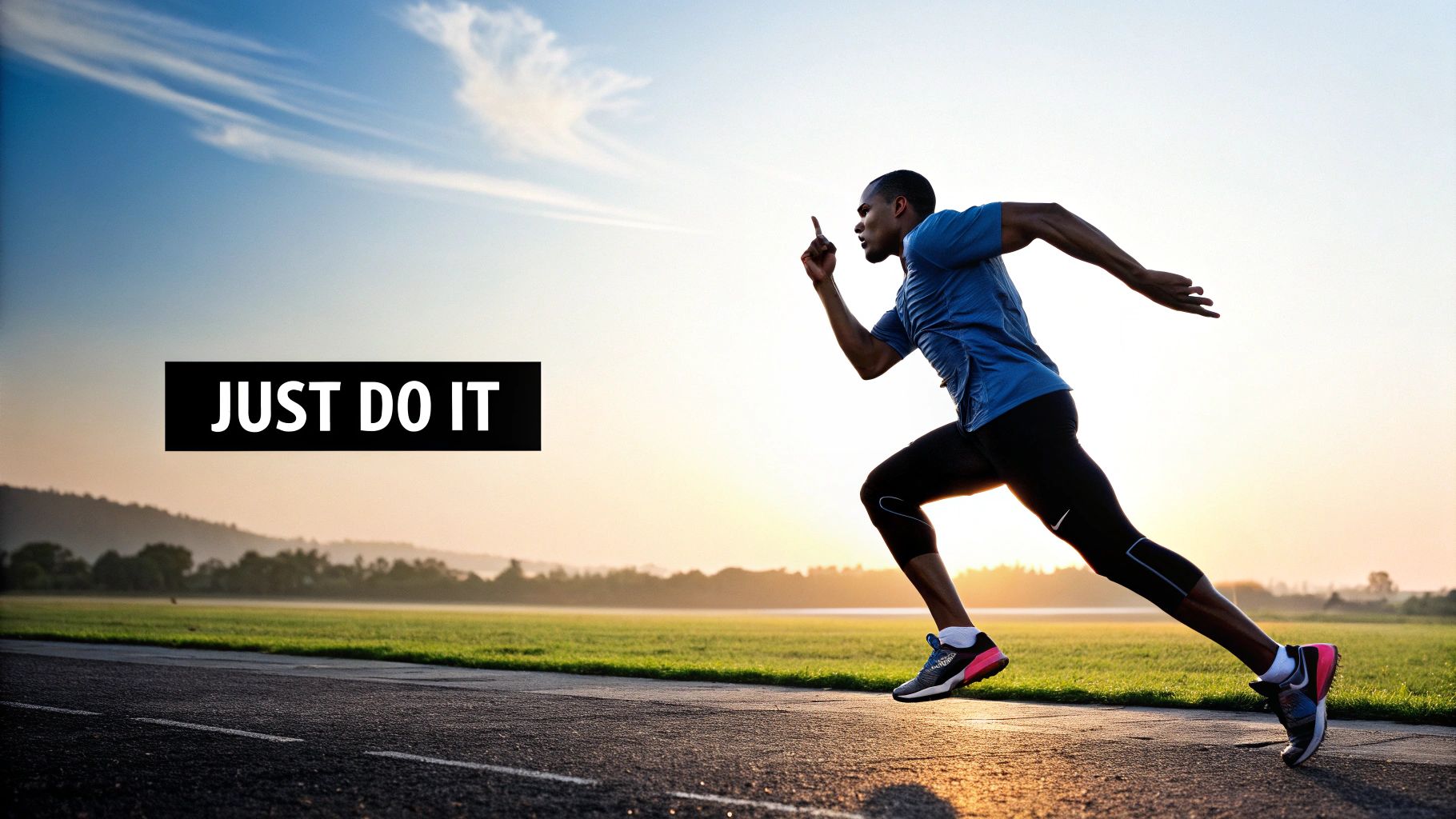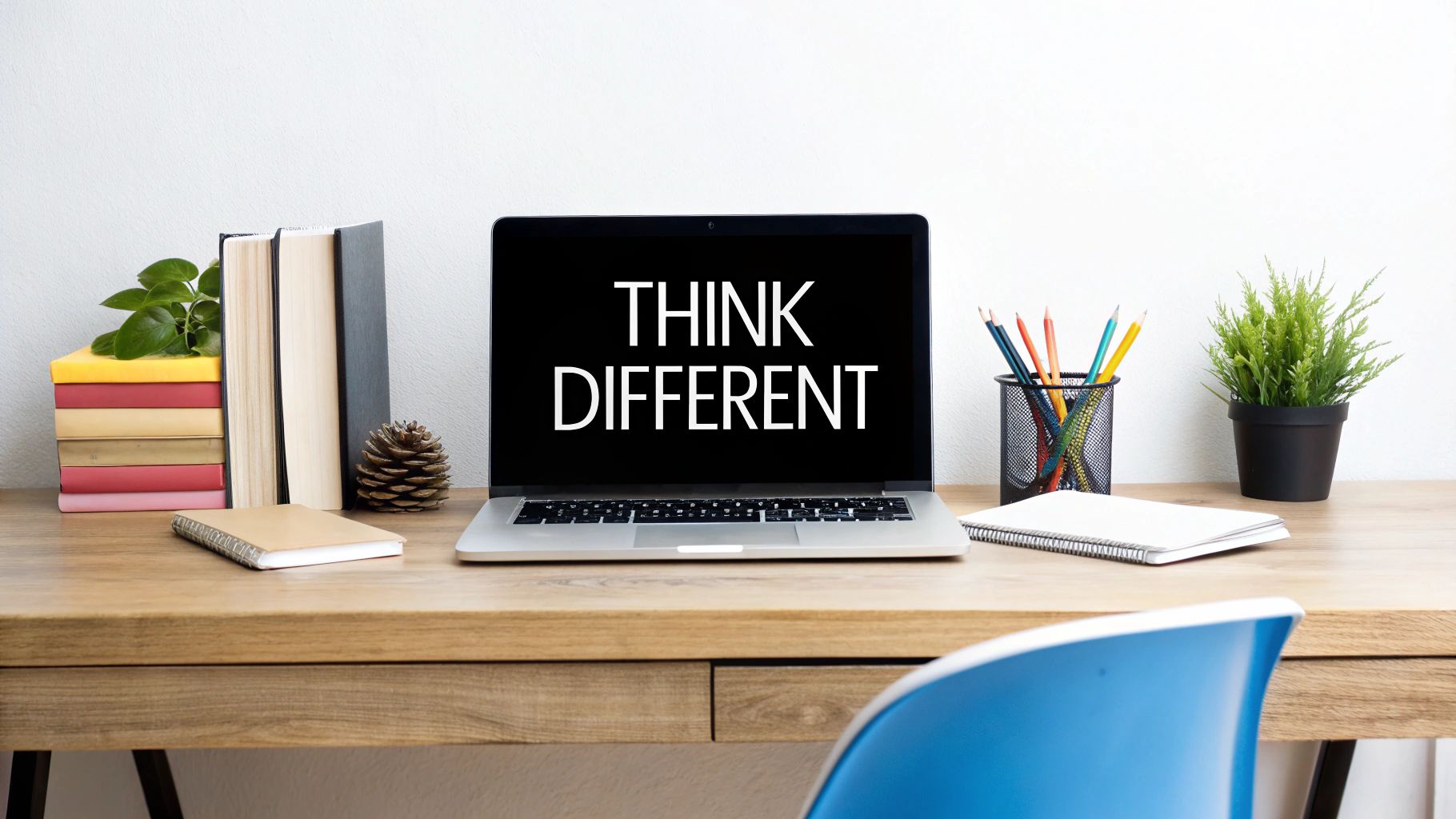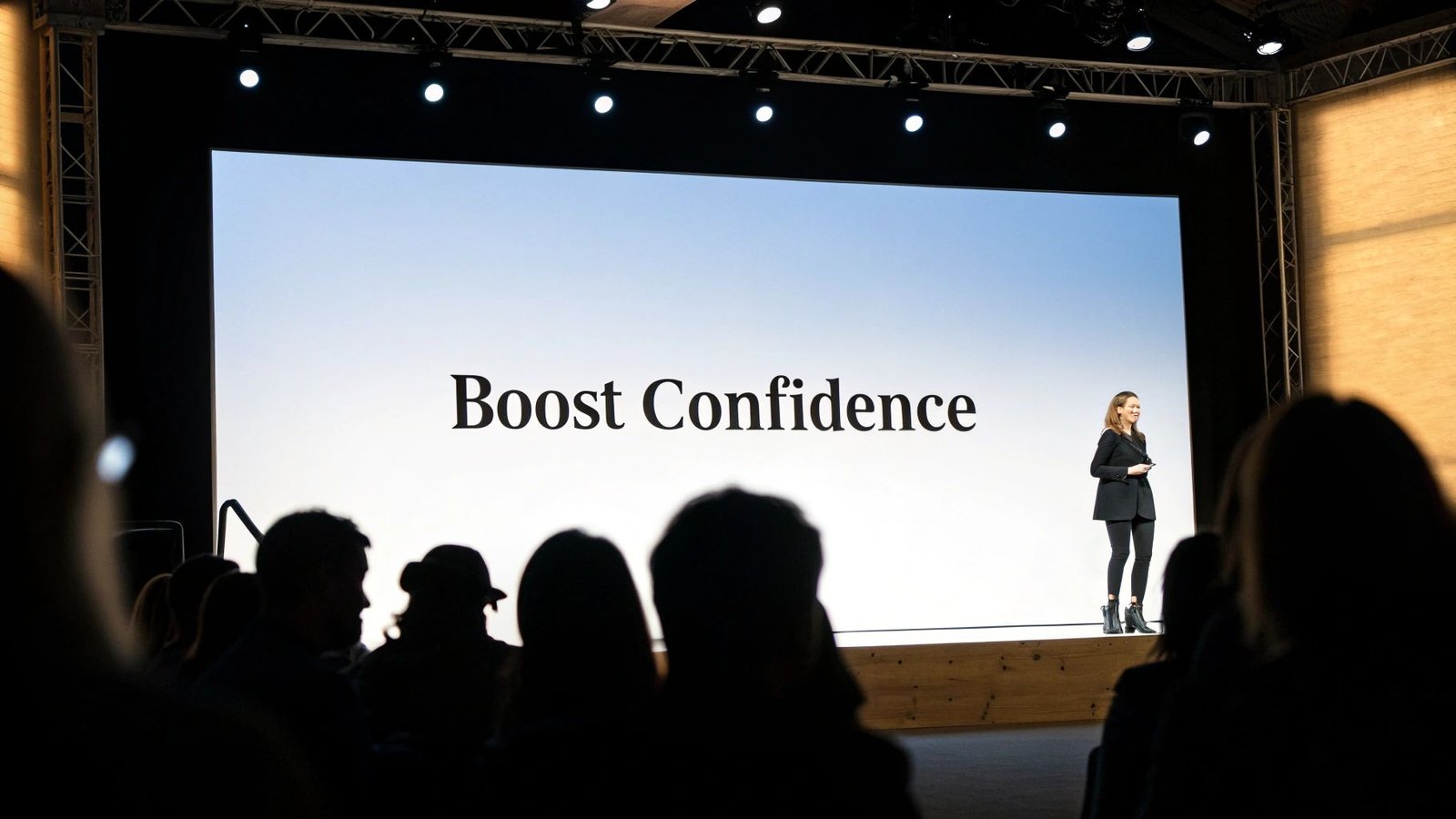24 March 2025

Crafting a Brand Statement That Truly Resonates
A brand statement is the foundation of any successful brand. It acts as a guiding principle, influencing everything from marketing strategies to customer service interactions. Think of it as the distilled essence of your brand's identity – a concise expression of its purpose, values, and unique promise. Whether you're an influencer cultivating a personal brand, a corporate executive leading a multinational company, or a coach connecting with your target audience, understanding the nuances of a resonant brand statement is crucial for building a lasting and influential brand.
Iconic slogans, like Nike's aspirational call to action, and empowering messages from beauty brands challenging conventional norms, have shaped consumer culture for decades. These powerful brand statements demonstrate a broader shift in marketing. The focus has moved away from simply highlighting product features and towards building emotional connections and fostering brand loyalty. The most effective brand statements tap into deep-seated human desires, aspirations, and values.
This creates a resonance that goes beyond simple advertising. These statements become synonymous with the brand itself, instantly recognizable and deeply connected to the emotions and experiences they evoke. Think about how certain brands make you feel. That's the power of a well-crafted brand statement.
This exploration into the art of the brand statement will examine eight examples from globally recognized brands. Each example will showcase a unique approach to connecting with their audience. We'll analyze the strategies behind their effectiveness, looking at the historical context, target audience considerations, and the lasting impact these statements have had on brand perception and market positioning.
By the end of this article, you'll understand the key elements of a truly unforgettable brand statement. You'll also be well-equipped to create one that resonates deeply with your own target audience, fostering connection and brand loyalty.
1. Nike's 'Just Do It'

Nike's 'Just Do It' is arguably the most recognizable slogan in the world. More than just a tagline, it's a cultural phenomenon embodying motivation, action, and the pursuit of athletic achievement. Created in 1988 by Dan Wieden of the Wieden+Kennedy advertising agency, this simple three-word phrase propelled Nike from a competitor to a global sportswear leader. Its inclusion on any list of impactful slogans is undeniable due to its widespread recognition, emotional impact, and enduring success.
One of the slogan's strengths is its simplicity. Just three words convey a powerful, universally applicable message. This action-oriented language transcends demographics, speaking to anyone striving for achievement, whether in sports or other areas of life. 'Just Do It' motivates action, encouraging individuals to overcome hurdles and pursue their aspirations.
This emotional connection is strengthened by Nike's consistent pairing of the slogan with inspiring athletes like Michael Jordan and Serena Williams, making them embodiments of the 'Just Do It' philosophy. Their images and stories resonate deeply with consumers, associating the brand with peak performance and overcoming adversity.
The Versatility and Impact of "Just Do It"
The versatility of 'Just Do It' is another asset. It applies seamlessly across Nike's product lines, from running shoes to basketball apparel, unifying the brand image and reinforcing its core message of athletic empowerment. This broad applicability contributes to its global recognition, transcending language barriers and connecting with diverse audiences.
The slogan's impact is undeniable. Between 1988 and 1998, Nike's market share grew from 18% to a remarkable 43%. Successful campaigns featuring iconic athletes further cemented 'Just Do It' in popular culture. This widespread recognition demonstrates the power of a concise, emotionally resonant message.
Challenges and Lessons
However, this ubiquity presents challenges. 'Just Do It' is so recognizable that it's susceptible to parodies and risks oversaturation. Refreshing such an iconic slogan is a delicate balancing act, as any significant change could diminish decades of brand equity. In some markets, the message's simplicity might be perceived as lacking depth.
Despite these challenges, 'Just Do It' remains a powerful example of effective branding. Its simplicity, action-oriented language, emotional resonance, and versatility contribute to its continued success. For influencers, executives, coaches, and business owners, 'Just Do It' offers valuable branding lessons.
Tips for Implementing Similar Strategies:
- Keep it simple and actionable: Brevity and a clear call to action are essential for memorability.
- Focus on emotional benefits: Connect with your audience emotionally, not just through product features.
- Align with core brand values: Your brand statement should reflect your brand's essence.
- Test for cross-cultural meaning: Ensure your message translates well and avoids negative connotations.
'Just Do It' exemplifies the power of a concise, emotionally charged message to build brand loyalty. Its enduring impact serves as inspiration and a benchmark for creating a resonant brand statement. Check out our article about Supersonify's Sitemap for more insights on content strategy.
2. Apple's 'Think Different'

Apple's 'Think Different' campaign, launched in 1997 after Steve Jobs' return, wasn't merely an advertising campaign. It was a powerful brand statement that revitalized a struggling company and reshaped its identity. This example is noteworthy because it showcases how a brand statement can go beyond product features and resonate with consumers on a deeper, emotional level. Instead of highlighting technical specifications, 'Think Different' celebrated creativity, innovation, and challenging conventions.
This campaign positioned Apple not simply as a computer manufacturer, but as a partner for creative professionals and innovators. It fostered a sense of community and belonging among those who saw themselves as forward-thinking and unconventional. The campaign's message resonated deeply with a target audience hungry for something more than just the latest technology. They wanted to be part of a movement, and 'Think Different' provided that opportunity.
One key aspect of 'Think Different' was its celebration of nonconformity. It associated Apple with visionaries like Albert Einstein, John Lennon, and Mahatma Gandhi. This instantly elevated the brand's image and linked it with groundbreaking achievements. The grammatically unconventional phrasing—"Think Different" instead of "Think Differently"—further emphasized this rebellious spirit and ensured the slogan's memorability. By focusing on mindset rather than products, the campaign achieved lasting relevance across multiple product generations.
Advantages and Limitations of the 'Think Different' Campaign
The 'Think Different' campaign offered several significant advantages. It created clear differentiation from competitors like IBM and Microsoft, who focused on more technical and business-oriented messaging. It forged an emotional connection with customers, cultivating a loyal following who saw Apple as an enabler of their vision. You might be interested in: Our guide on sitemaps to improve your website's visibility. This flexibility allowed the statement to endure for years, even as Apple’s products evolved. Crucially, 'Think Different' perfectly aligned with Apple's innovation-focused ethos, reflecting the company's core values.
However, the campaign also had its limitations. As Apple's brand evolved, the 'Think Different' slogan eventually felt less relevant and was retired. The statement's abstract nature meant it required significant contextual imagery—the black-and-white portraits of iconic figures—to convey its full meaning and connect it back to Apple's products. This reliance on visual context limited its versatility in certain media. It also offered a less direct connection to specific product benefits, relying more on an aspirational identity.
Examples of the 'Think Different' Campaign
- The iconic television commercial narrated by Richard Dreyfuss, featuring black-and-white imagery of historical figures.
- Print advertisements showcasing single images of innovators alongside the "Think Different" tagline.
- The association of the slogan with product launches and keynotes.
Implementing a Similar Strategy: Key Tips
- Focus on aspirational identity: Instead of listing product features, emphasize the identity your customers desire. What values are important to them?
- Consider grammatical uniqueness: A distinctive grammatical structure can increase memorability and impact.
- Align your statement with your company's authentic philosophy: Ensure your brand statement genuinely reflects your company's values.
- Use historical or cultural references: These can add depth and meaning, connecting your brand to a broader narrative.
'Think Different', popularized by Steve Jobs, Lee Clow (creative director at TBWA\Chiat\Day), stands as a testament to the power of a well-crafted brand statement. It successfully shifted Apple's perception from a struggling computer company to a symbol of creativity and innovation, leaving an enduring legacy on branding and advertising.
3. Coca-Cola's 'Open Happiness'
Coca-Cola's 'Open Happiness' campaign, which ran from 2009 to 2016, provides a perfect example of how a brand statement can elevate a product from a simple beverage to a symbol of shared experience and emotion. The campaign shifted focus from the drink itself and instead positioned Coca-Cola as something that brings joy, connection, and a sense of optimism. This resonated with consumers on a much deeper level, ultimately boosting the brand's global appeal.
One key aspect of this statement was its ability to link the simple act of opening a Coca-Cola bottle to the feeling of happiness. The physical action of "opening" became associated with unlocking a moment of joy. This simple but effective message worked across cultures, using the universal language of happiness, smiles, and shared moments. It also reinforced Coca-Cola's long-standing image as a positive brand.
The campaign's success was driven by its diverse implementation. For instance, there were the "Happiness Vending Machines," which gave out surprise gifts worldwide, and the "Small World Machines" project, which connected people in India and Pakistan through shared Coca-Cola experiences. Highly visible initiatives, such as Super Bowl commercials, strengthened the brand's message of happiness and social connection.
'Open Happiness' had several benefits. It was easily adaptable for global markets, creating emotional connections rather than focusing on the product’s function. The campaign built on the company's existing association with happiness and encouraged physical interaction with the product. Its flexibility allowed for a range of campaign implementations, from large-scale installations to personalized online content.
However, like any strategy, 'Open Happiness' wasn’t without its challenges. It was eventually replaced by the 'Taste the Feeling' campaign. Some critics felt the campaign overemphasized emotional benefits and needed significant multimedia support to convey its full message. This dependence on substantial marketing meant its impact was directly tied to consistent, high-budget investment.
For brands wanting to create similarly impactful statements, Coca-Cola's approach offers valuable lessons: connect the physical use of your product to positive emotional outcomes. Keep your language simple and easy to translate, especially for global brands. Draw on your existing brand associations, and use multi-sensory experiences to bring your message to life. You might be interested in: Our guide on… sitemaps and their structure for better SEO understanding.
This campaign is a key example because it showcases the strength of emotional branding. Though 'Open Happiness' is no longer Coca-Cola’s active slogan, its impact continues to shape brand strategy. It serves as a case study in connecting with a global audience through simple but effective messaging. The campaign, spearheaded by then-CEO Muhtar Kent, global chief marketing officer Joe Tripodi, and advertising agency Wieden+Kennedy Amsterdam, left an undeniable mark on advertising.
4. L'Oréal's 'Because You're Worth It'
L'Oréal's 'Because You're Worth It' is more than a tagline; it's a cultural phenomenon. First appearing in 1971, this statement changed beauty marketing by shifting the focus from pleasing others to individual self-worth. At a time when advertising often objectified women, L'Oréal empowered them to prioritize their own needs and desires. This resonated with consumers and justified the premium pricing of L'Oréal's products by framing beauty as self-investment.
One key feature is the use of second-person address. "You're" creates a direct, personal connection with the consumer. This simple structure also allows for easy adaptation across product lines and international markets. From hair color to skincare, the message of self-worth transcends specific product benefits, unifying the brand.
The statement's success lies in connecting product benefits to deeper emotional needs. By positioning beauty choices as acts of self-empowerment, L'Oréal elevates purchasing cosmetics beyond vanity. This emotional validation justifies the higher price, as consumers invest in their self-esteem.
L'Oréal's commitment to evolving the statement while keeping its core message is another key to its longevity. Originally used to justify the higher price of Preference hair color, the slogan has adapted to reflect changing values. The evolution to "Because We're All Worth It" shows the brand's commitment to inclusivity, embracing a broader definition of beauty. This adaptability has allowed the statement to resonate across generations, demonstrating its enduring appeal.
Pros:
- Appeals to multiple generations
- Justifies price premium through emotional connection
- Successfully updated over time
- Positions brand as a consumer advocate
- Translates well across international markets
Cons:
- Sometimes criticized for commercializing feminism
- Occasionally seen as materialistic
- Requires careful navigation of evolving beauty standards
Examples:
- Original use: Justifying the price of Preference hair color
- Evolution: "Because We're All Worth It" for inclusivity
- Diverse spokesmodels: From Jane Fonda and Viola Davis to Jennifer Aniston, Beyoncé, and Eva Longoria
Tips for Implementing a Similar Strategy:
- Connect product benefits to emotional needs.
- Use direct address for a personal connection.
- Ensure the statement can evolve.
- Address potential objections (like price) directly.
Check out our article about Sitemaps for more insights into content strategy and SEO.
L'Oréal's 'Because You're Worth It' deserves its place on this list. It's a brand statement that transcends advertising and becomes a cultural touchstone. By understanding its evolution and impact, influencers and business leaders can learn valuable lessons about crafting compelling messages and building brand loyalty.
5. BMW's 'The Ultimate Driving Machine'
BMW's 'The Ultimate Driving Machine' is a classic example of effective branding. Since 1974, this short, memorable phrase has conveyed the company's core value and shaped its identity. Instead of focusing on luxury or status, BMW chose to emphasize the thrill of driving, establishing itself as a performance-driven carmaker. This focus has been the foundation of BMW's marketing, product development, and brand perception for almost 50 years.
The statement's power lies in its precision and boldness. The claim of being the "ultimate" driving machine sets a high bar. It highlights engineering excellence and a driver-centric approach, appealing to the desire for an exciting driving experience and the appreciation for advanced technology and precise engineering. This positioning differentiated BMW from competitors focused solely on luxury, allowing them to charge premium prices based on their performance promise.
The statement's impact is evident in its consistent use across decades of advertising. Even a short-lived shift to the 'Joy' campaign eventually returned to the reliable 'Ultimate Driving Machine,' proving its enduring relevance. BMW's continued focus on driving dynamics and its motorsport history reinforce this consistency, offering tangible evidence of their commitment to performance.
However, the statement presents challenges. It creates high expectations that every BMW must meet. Changing societal views on car ownership, particularly regarding environmental concerns and the rise of autonomous driving, require careful consideration to maintain the statement's relevance. In markets with driving conditions or regulations that limit performance, the statement's impact can be reduced.
Features
- Makes a superlative claim ('ultimate') about core product function
- Focuses on performance, not status or looks
- Emphasizes engineering and driving dynamics
- Projects confidence with definitive language
- Sets BMW apart from luxury competitors
Pros
- Creates clear, consistent brand differentiation
- Guides internal product development standards
- Appeals to both emotional and rational decision-making
- Remains relevant despite automotive technology changes
- Supports premium pricing based on performance
Cons
- Sets high expectations for all products
- Challenged by changing attitudes towards car ownership
- Less impactful where driving conditions restrict performance
Examples
- Consistent use in advertising over decades
- Brief replacement by 'Joy' campaign before returning to the original statement
- Supported by a continuous focus on driving dynamics in engineering
Tips for Similar Strategies
- Focus brand statements on core functional differences
- Use confident, definitive language to build credibility
- Ensure every product delivers on the core promise
- Maintain consistency, even with product line expansion
You might be interested in: Our guide on…
Popularized By:
- Bob Lutz (Executive VP at BMW during slogan adoption)
- Ammirati & Puris advertising agency
- BMW's motorsport history and racing success
BMW's 'The Ultimate Driving Machine' deserves recognition because it showcases how a well-crafted brand statement can shape a company's identity and guide its long-term success. It highlights the value of focusing on a core differentiator, communicating it confidently, and consistently reinforcing it through product development and marketing. This statement's lasting power offers valuable lessons for any brand aiming to establish a strong and enduring market presence.
6. Airbnb's 'Belong Anywhere'

Airbnb's 'Belong Anywhere' brand statement, launched in 2014, resonates deeply with travelers. It shifted the company's image from just another accommodation provider to something more. Airbnb became a facilitator of genuine human connection and a sense of belonging. This resonated especially well with millennials and Gen Z, demographics known to prioritize experiences over material goods.
This change wasn't just clever marketing; it became core to Airbnb's business strategy. The statement itself presents an intriguing paradox: belonging is usually tied to a specific place, yet Airbnb promises it anywhere. This contradiction sparked the imagination of travelers looking for more than just a place to sleep. It spoke to a basic human need: connection and acceptance, no matter where you are.
Key Features and Benefits
-
Transforms Functional Service Into Emotional Promise: 'Belong Anywhere' elevates booking a room into joining a community.
-
Addresses Fundamental Human Need for Belonging: It taps into our universal desire for connection and acceptance.
-
Positions Brand as Enabler of Authentic Experiences: Airbnb isn't just about finding a bed; it's about connecting with local cultures and people.
-
Encompasses Both Hosts and Guests: The statement works for hosts who want to share their culture and connect with travelers, strengthening the sense of community.
Pros and Cons
Pros:
-
Differentiation: The slogan sets Airbnb apart from traditional hotels focused on amenities and luxury.
-
Guides Product Development: 'Belong Anywhere' inspired expansion beyond accommodation, like the 'Experiences' platform.
-
Global Appeal: The idea of belonging transcends cultural differences, enabling consistent global branding.
-
Premium Pricing Justification: Authentic experiences justify higher prices than standard hotel rooms.
Cons:
-
Inconsistency: Maintaining consistent host quality and positive guest experiences across diverse locations presents an ongoing challenge.
-
Regulatory Hurdles: Airbnb's decentralized model has faced regulatory pushback in some areas.
-
High Expectations: Promising "belonging" sets a high bar, which can be difficult to consistently meet.
Real-World Examples
-
Brand Redesign: The 'Belong Anywhere' launch coincided with a complete brand redesign, reflecting the strategic shift.
-
Experiences Platform: The statement laid the groundwork for the 'Experiences' platform, allowing hosts to offer unique activities and foster deeper connections.
-
Pandemic Response: During the COVID-19 pandemic, Airbnb used the "belonging" concept to promote longer stays for remote workers and digital nomads.
Tips for Implementation
-
Connect Functional Benefits to Emotional Needs: Figure out the underlying psychological needs your product or service fulfills.
-
Consider All Stakeholders: Think about how your brand statement impacts everyone involved (e.g., customers, employees, partners).
-
Guide Expansion: Use your brand statement as a guide for developing new offerings and expanding into new markets.
-
Address Psychological Needs: Look beyond practical benefits and focus on fulfilling deeper human desires.
Popularized By
- Brian Chesky (Airbnb co-founder and CEO)
- DesignStudio (rebrand design agency)
- User-generated content showcasing diverse hosting experiences
Airbnb’s success with 'Belong Anywhere' shows how a strong brand statement can reshape an entire industry. By focusing on fundamental human needs and building a sense of community, Airbnb has carved a unique niche in the travel market and continues to inspire brands across various sectors.
7. Dove's 'Real Beauty'

Dove's 'Real Beauty' campaign, launched in 2004, is a prime example of how a brand statement can reshape a company's identity and create a significant cultural impact. Its inclusion on this list highlights the power of aligning a brand with a strong social message, achieving both commercial success and positive societal change. Instead of showcasing aspirational and often unrealistic beauty standards, Dove chose to celebrate the diversity and authenticity of real women. This approach resonated with consumers, changing Dove's image from a simple soap brand to an advocate for broader definitions of beauty.
The campaign's core tenets included challenging industry norms and established beauty standards. Authenticity became its key differentiator, combining commercial goals with a clear social purpose. By featuring real women instead of professional models in their advertising, Dove entered the cultural conversation about body image and self-esteem, going beyond mere product benefits.
This strategy yielded many positive results. It forged a strong emotional connection with consumers, significantly increasing brand relevance and sales. The 'Real Beauty' platform provided a long-term foundation for brand communication. It also set Dove apart in the competitive personal care market and expanded its target audience beyond traditional beauty consumers.
Examples of Campaign Success
The campaign's success can be attributed to several key initiatives. One iconic example is the 'Evolution' video, which powerfully exposed the manipulation behind idealized beauty images. The Dove Self-Esteem Project further solidified the brand's commitment, reaching millions of young people with educational programs that promoted positive body image. Over time, 'Real Beauty' evolved from a campaign into a comprehensive brand mission, deeply embedded in Dove's identity.
Navigating Challenges and Criticism
The journey, however, has not been without its difficulties. Dove faced criticism for perceived inconsistencies between the 'Real Beauty' message and the marketing practices of its parent company, Unilever. This was particularly true regarding other beauty brands within Unilever's portfolio. Occasional missteps in campaign execution also attracted scrutiny, reminding brands of the importance of careful planning and sensitivity. Additionally, Dove faces growing competition in the purpose-driven marketing space, requiring constant innovation and commitment to maintain its leading position.
Tips for Implementing a Similar Strategy
-
Align brand statements with authentic organizational values: The 'Real Beauty' campaign resonated because it reflected a genuine commitment within Dove. Ensure your brand statement aligns with your core values to build trust and avoid appearing inauthentic.
-
Address cultural tensions relevant to your category: Dove tapped into existing anxieties surrounding body image and beauty standards. Identify relevant cultural conversations within your industry and offer a meaningful perspective.
-
Back statements with substantive action and programs: The Dove Self-Esteem Project provided tangible support for its message. Don't just make statements; create programs and initiatives that demonstrate your commitment.
-
Be prepared to commit long-term to brand positioning: 'Real Beauty' has been a long-term commitment for Dove. Building a purpose-driven brand requires sustained effort and investment.
Key figures involved in the campaign's popularization include Silvia Lagnado (Dove Global Brand Director during the launch), the creative team at Ogilvy & Mather, and Susie Orbach, a psychotherapist and body image expert who consulted on the project. Their combined expertise in branding, advertising, and psychology contributed to the campaign's significant impact. While Dove doesn't have a dedicated website solely for the 'Real Beauty' campaign, information is available on their main website and through online searches.
8. Patagonia's 'Build the Best Product, Cause No Unnecessary Harm'
Patagonia's brand statement, "Build the Best Product, Cause No Unnecessary Harm," clearly communicates a dual commitment: exceptional product quality and minimal environmental impact. This simple statement is fundamental to Patagonia's identity, shaping business decisions and resonating with environmentally conscious consumers. Unlike brand statements focused solely on consumer benefits, Patagonia acknowledges the tension between manufacturing and environmental responsibility. This transparent, principled approach positions the brand as a leader in sustainable business.
This statement is noteworthy because it shows how a brand statement can be more than just marketing. It can be a guiding principle influencing every aspect of a business. Patagonia's statement acts as an operational compass, informing everything from material sourcing and design to manufacturing and marketing.
Putting Principles Into Practice
This commitment is visible in features like the "Common Threads Initiative," which encourages repair and reuse. It's also evident in their pioneering use of recycled materials in performance apparel. Patagonia's dedication to minimizing environmental impact is further demonstrated by their "1% for the Planet" commitment, donating a percentage of sales to environmental organizations. These initiatives aren't just marketing tactics; they're tangible expressions of the brand statement in action.
Patagonia's approach has made a real difference. Let’s break down the pros and cons:
Pros:
- Authentic Differentiation: Patagonia’s commitment to sustainability sets them apart in a crowded outdoor apparel market, attracting values-driven consumers.
- Premium Price Justification: This commitment justifies premium prices, as consumers will pay more for products aligned with their values.
- Internal Alignment: The statement guides decision-making across the organization, ensuring consistent action.
- Enhanced Credibility: Openly acknowledging the environmental impact of manufacturing builds trust.
- Innovation Framework: The statement provides a framework for innovation, pushing the company to explore new, eco-friendly materials and manufacturing processes.
Cons:
- High Standards: Maintaining such a high environmental standard requires constant effort and investment.
- Cost Implications: Sustainable practices can be more expensive, potentially impacting price competitiveness.
- Increased Scrutiny: Patagonia’s commitment invites public scrutiny, holding them accountable for every decision.
The Philosophy and Its Evolution
The philosophy, "Build the Best Product, Cause No Unnecessary Harm," is largely credited to founder Yvon Chouinard and Vincent Stanley, Patagonia's Director of Philosophy. Their vision, amplified through activism campaigns, has popularized the idea that businesses can be a force for good. This concept's evolution is tied to growing environmental awareness, as consumers increasingly seek values-aligned brands.
Implementing a Similar Approach
Here are some tips for adopting a similar approach:
- Operationalize Your Values: Integrate core operational commitments into your brand statement.
- Embrace Transparency: Honestly acknowledge any trade-offs and limitations.
- Guide Decision-Making: Use your brand statement to inform all business decisions.
- Consider the Lifecycle: Factor in the entire product lifecycle—from sourcing to disposal—into your brand positioning.
Patagonia's website provides more information on their mission and practices. Their approach proves a well-crafted brand statement can be a powerful tool, not only for attracting customers, but also for shaping company culture, driving innovation, and making a positive global impact.
8-Point Brand Statement Comparison
| Title | Implementation Complexity 🔄 | Resource Requirements ⚡ | Expected Outcomes 📊 | Ideal Use Cases 💡 | Key Advantages ⭐ |
|---|---|---|---|---|---|
| Nike's "Just Do It" | Low – Simple, actionable three-word slogan | Minimal – Straightforward creative execution | High brand recognition and emotional connection | Brands seeking universal, motivational messaging | Instant recognition; emotional impact; versatility |
| Apple's "Think Different" | Moderate – Requires iconic visuals and deep narrative | Significant – Strong creative and cultural integration required | Distinct market repositioning and brand revival | Brands emphasizing innovation and creative nonconformity | Differentiation; inspirational; long-term brand turnaround |
| Coca-Cola's "Open Happiness" | Moderate – Involves integrated, multimedia campaigns | High – Extensive campaign and global marketing support | Broad emotional appeal and enhanced global connection | Global brands leveraging experiential, emotional storytelling | Global appeal; emotional resonance; campaign integration |
| L'Oréal's "Because You're Worth It" | Moderate – Evolved over decades, requiring consistency | Moderate – Ongoing marketing and adaptation to cultural shifts | Sustained emotional connection and justification of premium pricing | Beauty and lifestyle brands seeking empowerment messaging | Empowering; timeless; adaptable messaging |
| BMW's "The Ultimate Driving Machine" | Moderate to High – Demands alignment with rigorous product performance | High – Significant commitment to engineering excellence and quality assurance | Clear brand differentiation with premium value perception | Luxury and performance-focused brands | Performance promise; consistent legacy; distinct differentiation |
| Airbnb's "Belong Anywhere" | Moderate – Shifts focus from transactional to transformational experiences | Moderate – Involves cross-functional coordination and community engagement | Enhanced customer loyalty and repositioned travel experience | Service brands aiming to create authentic community connections | Transformative; inclusive; community-driven |
| Dove's "Real Beauty" | High – Challenges societal norms with a socially charged campaign | High – Demands deep creative insight and sustained social commitment | Strong cultural impact and significant sales uplift | Brands aiming for purpose-driven, socially resonant marketing | Emotional resonance; inclusivity; cultural influence |
| Patagonia's "Build the Best Product, Cause No Unnecessary Harm" | High – Integrates product excellence with strict environmental principles | High – Requires commitment to sustainable practices and operational trade-off | Elevated credibility in sustainability with loyal, values-driven customers | Brands committed to ethical practices and sustainability | Authenticity; sustainability leadership; operational integrity |
Elevating Your Brand With a Powerful Statement
From Nike's motivational call to action to Patagonia's commitment to sustainability, the brand statement examples we've explored demonstrate the power of a concise and compelling message. Several key principles emerge: authenticity, clarity, resonance with the target audience, and alignment with core values. By focusing on these elements, you can create a brand statement that serves as a guiding star for all your branding efforts.
Applying these concepts requires a deep understanding of your brand's essence. Who are you? What do you stand for? What unique value do you offer? Answering these questions honestly and thoughtfully will lay the foundation for a powerful brand statement. Remember, your statement isn't just a tagline; it's the heart and soul of your brand, influencing everything from your marketing materials to your customer interactions.
Building a strong brand is an ongoing journey. Continuously analyze the effectiveness of your brand statement. Is it resonating with your audience? Is it driving the desired results? Be prepared to adapt and refine your message as your brand evolves and the market changes. Stay attuned to ongoing trends, such as the increasing emphasis on purpose-driven branding and personalized experiences, to ensure your brand remains relevant and impactful.
Key Takeaways
-
Authenticity is paramount: Your brand statement must reflect your genuine values and beliefs.
-
Clarity is essential: A concise and easily understood message is more impactful.
-
Resonance matters: Connect with your target audience on an emotional level.
-
Alignment is key: Ensure your brand statement guides all aspects of your brand experience.
-
Adaptation is crucial: Be prepared to refine your message as your brand evolves.
Ready to transform your brand into a force of influence? Supersonify's approach is built around you – your story, your values, your goals. We don’t offer one-size-fits-all solutions; we craft a personalized branding strategy that highlights your strengths and showcases your distinct identity. From refining your messaging to enhancing your personal image, we develop tailored solutions that make your expertise and potential stand out. Discover the power of a truly authentic brand. Visit Supersonify today and let us help you amplify your voice and achieve your branding goals.





